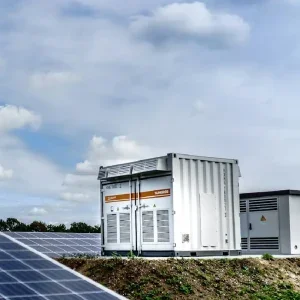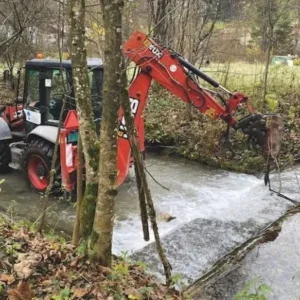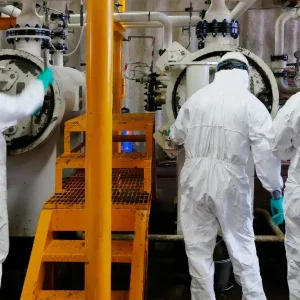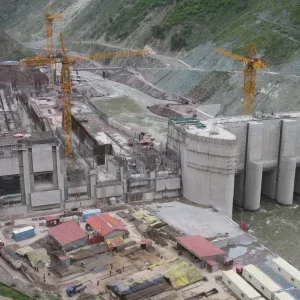Purdue University’s State Utility Forecasting Group (SUFG) has been working with the twelve member countries of the Southern African Power Pool (SAPP) over the past four years (1996 to 2000) to develop a cost minimising model for long term (2000 to 2020) capacity expansion planning. The results from the modelling show that whatever demand forecast is applied (high, medium or low growth rates), in all cases over 70% of the generation expansion requirements should be met from hydro power. In the high growth scenario this will mean the construction of over 33,000MW and in the low growth scenario this means nearly 19,000MW.
The country with the highest hydro power potential is the Democratic Republic of Congo (DRC). Hydro power capacity expansion modelling shows that construction of 13,000MW to 26,000MW at the Inga site in DRC on the river Congo, will give many economic benefits to the region. Significant hydro expansions are also optimally cost-effective for South Africa (pumped storage), Mozambique and Malawi.
SAPP
SAPP was formally established by the energy ministers of the Southern African Development Community (SADC) in 1995. SADC is an organisation which promotes economic co-operation among ten Southern African countries.
One of the main purposes of SAPP is to co-ordinate and co-operate in the operation of (SAPP) systems to minimise costs while maintaining reliability. This objective is expected to be achieved through a greater use of the region’s potential hydro power. With economic and regional technical data, supplied by SAPP management to the Purdue modelling team, it is being confirmed that it is cost-effective to the region as a whole to use greater amounts of hydro power. The Purdue modelling quantifies the extent to which hydro power should be developed in accordance with the expected demand growth rate and for minimum costs specifying countries and actual sites. The countries in the SAPP are:
• Angola.
• Botswana.
• Democratic Republic of Congo (DRC).
• Lesotho.
• Malawi.
• Mozambique.
• Namibia.
• Republic of South Africa.
• Swaziland.
• Tanzania.
• Zambia.
• Zimbabwe.
DRC and Tanzania, while being SAPP members, are not members of SADC.
The two largest rivers in the region are the river Congo, mainly within DRC, and the Zambezi river which links Zimbabwe, Zambia and Mozambique. Construction plans for new hydro power on the river Congo at the Inga site show the Fwamalo canal carrying 5000m3/sec. Expansion at this site is estimated to cost US$7B for 24,000MW of extra power. Substantial revenues will accrue to DRC through this construction because the bulk of the generation will be for export. The per capita gross national product (GNP) of DRC was US$343 in 1997.
The economies across the region vary significantly from country to country. Electricity export earnings provide a big boost to major hydro power economies while also providing significant production cost savings to major electricity importing countries like Zimbabwe and South Africa.
The wealthiest country in the SAPP is South Africa and the lowest income goes to Mozambique (see table on the left).
The percentage of the populations that have access to electricity varies from 2% in DRC and Lesotho, to 13% in Tan-zania and 16% in Zimbabwe. The 45% access figure for South Africa (in 1995) has now been considerably increased over the past few years through a major electrification programme. This programme is promoted by the government and the country’s large electricity utility, Eskom. Eskom is the fifth largest utility in the world with nearly 38,000MW of generation capacity, (which includes its mothballed capacity).
Electricity consumption per capita is generally very low in SAPP. For the purpose of comparison, the per capita consumption rate in the US in 1995 was 11,571kWh. South Africa consumes per capita the same as Greece (3259kWh in 1995). All of the other countries in the pool have far lower consumption rates.
Each SAPP country has a national utility controlled by its government and some countries have a few small municipal power organisations. These national utilities are:
• Botswana Power Corporation (BPC).
• Electricidade de Mocambique (EDM).
• South Africa Parastatal Power Utility (Eskom).
• Lesotho Electricity Corporation (LEC).
• Namibia Parastatal Power Utility (NamPower).
• Swaziland Electricity Board (SEB).
• Societe National d’Electricite DRC (SNEL).
• Zimbabwe Electricity Supply Authority (ZESA).
• Zambia Electricity Supply Corporation (ZESCO).
• Empresa Nacional de Electricide Angola (ENE).
• Electricity Supply Commission of Malawi (Escom).
• Tanzania Electric Supply Company (TANESCO).
The major hydro power countries are DRC, Zambia, Mozambique, Zimbabwe, and Tanzania.
The SAPP is managed through an international board of senior utility executives who answer to the SADC energy ministers. The Purdue modelling work has been conducted primarily through collaboration with the SAPP planning subcommittee.
Generating capacities
The total current hydro power generating capacity within the SAPP region is 9363MW. This represents about 22% of the region’s current total generating capacity (see table above).
DRC, Malawi, and Mozambique are effectively totally hydro power countries. The only thermal power that is used in Mozambique comes from imports from the Johannesburg area of South Africa.
At present Mozambique has the largest hydro power facility in the region at Cahora Bassa in the north of the country on the Zambezi river. The peak electricity demand in Mozambique is less than a tenth of the capacity of Cahora Bassa. Most of Cahora Bassa’s hydroelectric power is intended for export to South Africa.
South Africa is a 94% thermal power country having large reserves of coal. Most of the large stations in South Africa are built on the coal mining sites of the greater Johannesburg area. The bulk of South Africa’s hydro power consists of 1872MW of pumped hydro stations, at Gariep and Vanderkloof (see table below).
The large Kariba hydro power station is also on the Zambezi river, up-stream of Cahora Bassa and its capacity is shared by the utilities of Zambia and Zimbabwe. Kariba North (Zambia) receives 600MW and Kariba South (Zimbabwe) gets 750MW. Zambia’s Kafue station is one of the larger hydro power installations in the region with a capacity of 900MW.
SAPP identified that 62% of the proposed generating capacity expansion projects (see table on p18) are in hydro power, with the largest development being at the Inga site in DRC. The modelling analysis conducted at Purdue shows that under high growth scenarios, with an average regional demand growth of 5.1%, all of this proposed hydro power capacity should be built. Throughout the modelling tests, the proposed new pumped storage stations in South Africa are always selected as being highly economical for the region. The very large expansions at the Inga site involve four proposed stages of development with each stage having 4750MW of capacity and in units of 750MW.
Of the 12 countries in SAPP, only three have no plans to construct new hydro power capacity, these are: Botswana, Swaziland and Lesotho. Lesotho has only recently commissioned a new hydro site at Muela. Just over 90% of the SAPP region’s existing thermal generating capacity is found in South Africa. The only large existing thermal station outside of South Africa is in Zimbabwe at Hwange (847MW). The Hwange station, like most of those in South Africa is built on a coal mining site.
The SAPP planning policy is based on the assumption of an average regional demand growth of 4.1%. Over the next few years the countries of Angola and Namibia are predicted to have growth rates of 9.9% and 11.3% respectively. The South African utility Eskom, has a projected growth of 2.4% to 2.7% over the next 20 years. This is only marginally higher than the average demand growth that is predicted for regions in the industrialised nations of North America and Europe. Growth rates in Botswana, DRC, Malawi, Mozambique, Swaziland, and Zambia are all above 4%. In the case of Tanzania there is another consistently high growth rate of over 7%.
All of the utilities in the region are predominantly government owned. Several countries in the pool are developing ideas on utility restructuring and are exploring the role of the private sector. Over the years, the policy of SAPP governments for regional development in electricity generation, has looked towards the wheeling of cheaper hydro power from the northern countries in the region to the thermal generation dominated countries of the south (mainly to South Africa and Zimbabwe). Long international transmission lines are involved in this plan. The existing DC line that connects HCB to South Africa is 1420km long. These long lines incur significant power losses but the benefits of hydro power expansion are still believed to be a planning priority for the region and are confirmed in the modelling work.
At present the only countries with full time electricity regulatory staff, appointed by governments, are Zambia and South Africa. In 1999 the government of Zimbabwe passed legislation to create a regulatory body in the country. As SAPP countries start to think through the issues of unbundling and competition, the role of these regulators will become more important. To date there has been some diversification towards considering private power producers. Introducing private companies in a region of high rates of inflation is expected to create problems when deciding a market price for electricity.
In 1996 the SAPP management decided to create a co-ordinating centre. This is now located in Harare and will take on a vitally important role as the electricity supply of the region becomes more market driven.
The Purdue-SAPP long term model has been developed over the past few years with a collaborative agreement between Purdue and the SAPP management. The expert modellers in the SAPP Planning and Generation Working Group (PGWG) have both worked on the structure of the model and on the collection of reliable data from the 12 countries in the SAPP.
Enormous potential
The GPWG modellers have their main testing base for the model in Johannesburg at the Eskom headquarters. In August 2000, the SAPP management officially confirmed that the Purdue model will be used as the SAPP primary long-term planning tool.
In February 2001 the SAPP-PSC will submit a pool expansion plan that is based upon this model. The results of this pool plan will be discussed further among the utilities for much of 2001. A SAPP international investors conference will also take place in 2001, and the results of the Purdue model and the SAPP plan will be an important part of the presentations.
The mathematical programming for the power pool policy analysis can be either in an integer or linear mode. With the integer mode this means that the optimisation and project selection process will require the consideration of complete generation units to be constructed. This mode of operation is required in a final planning analysis but the linear mode, which permits portions of generating units to be built, is very helpful as it shows the optimal tendencies in the selection of the generation technology and preferred unit sixes. The linear mode of the model also required much less time in its execution and it is the version used in this study.
GAMS and CPLEX solvers are employed to write and execute the mathematical model. GAMS (general algebraic modelling System) was developed to provide a high-level language for the compact representation of large and complex models. It allows changes to be made in model specifications simply and safely and can be easily used by economists and engineers as well as programmers. GAMS is designed to make concise algebraic statements of models in a language that is easily read by the modeller and the computer.
CPLEX is a commercial software solver, used with GAMS, for executing the billions of optimising iterations in order to arrive at the optimal least cost construction solution.
International perspectives
When the model is run in the ten period linear programming mode, with the 14 nodes, then about two hours of running time is required. The model assumes that the demand and supply for each country all act at one point. The model is spatial from an international perspective. It analyses the international electricity trade and capacity expansions from an international view point and not within each country. For the countries of Mozambique and South Africa, two nodes are provided in the model. Mozambique does not have a fully integrated national grid and the national transmission spine within South Africa (going from Johannesburg to Cape Town) constitutes two major demand centres.
Each period in the ten period analysis has a duration of two years. Capacity expansions are compared for the various growth scenarios; high, medium, and low. The medium scenario is the base scenario with the high scenario being 25% higher than the base values, and the low scenario has growth values 25% less that the base ones.
A summary of the typical capacity expansion plan is demonstrated by the results shown in table 7. In the base scenario, (medium growth of 4.1%) the new hydro (NH) expansions amount to 21,341MW. The existing hydro installations are expanded upon by 1015MW in all three growth scenarios. In all growth scenarios the 3997MW of pumped storage in South Africa, is also always selected by the model. In the high growth scenario an extra 7000MW of new hydro power is proposed to be built. In all three growth scenarios a capacity expansion of the old hydro stations always takes place. The capacity expansions for hydro power plays a major part with more than 70% of totally new capacity being in hydro power for each of the growth scenarios.
In the high growth scenario there is also a very large increase in new thermal power stations (large coal stations greater than 500MW in South Africa) that are prioritised. In the low growth scenario the construction of large coal stations is not prioritised at all. The construction of small coal plants in each scenario refers to the refurbishment of mothballed stations in South Africa. With present rehabilitation costs in the country this construction policy is very economical.
Most of the new hydro power capacity will actually be built in DRC with 20,055MW to be built with the medium growth base case scenario (see table below). The country which will have the next most significant expansion in new hydro power is Malawi with 988MW. All of the results from the model are very sensitive to fixed and variable cost data.
There never was, nor will there ever be, a model that perfectly mimics reality, particularly in situations as complicated and interdependent as hydro power expansions, and indeed all investments in the SAPP project. All models can do is suggest areas and issues where further analysis is needed. Readers should be made aware of the limitations of these models, particularly limitations that might systematically bias the results for or against one or another of the technologies competing in the model for investment funds.
Chief among such limitations is the assumption that the future is certain. The model is clairvoyant, in the sense that all parameters and most important among them, both electricity demands and supply costs, are known with certainly. There are no ‘surprises’ in the model, in the sense that half way through users discover that expected demand growth is much less than expected, and/or the capital or fuel costs of a particular generating unit have been greatly underestimated. These shortcomings tend to favour large, unique projects with substantial front end costs and construction lead times relative to smaller, ‘off the shelf’ projects with lower front end costs and shorter construction lead times. Put another way, clairvoyant models never give the second type of project the opportunity to show how much more flexible they are in adjusting to unexpected developments; if demand does not materialise, the schedule of additions of smaller plants is simply postponed until demand appears. Since the second type of project involves by assumption well tested technologies, cost surprises, if they do take place, tend to be smaller than the surprises associated with unique projects.
It is the authors belief that the large hydro projects contemplated by SAPP are projects of the first type, while the thermal units are of the second type. The SAPP hydro projects are good examples of so-called ‘knife edge’ electricity generation technologies – technologies whose cost per MWh are very low if the demand scenario expected in fact materialises, but whose costs tend to rise quickly if the scenario is lower or higher than was planned for.
The reason for this is that once started, large hydro projects have little downsizing or construction postponing capability when compared to SAPP thermal units. Dams of the sort contemplated by SAPP must either be completed as designed or not started. There is little opportunity to alter the design capacity of the reservoir once construction has started. Politically embarrassing mothballing is probably the only answer.
Hidden bias
Thermal units, in particular natural gas-fired combined cycle units, contemplated by SAPP, are good examples of more flexible technologies whose performance is not as affected by surprises in either the demand or cost scenarios. This is because the combined cycle technology (CC) has much smaller construction lead times, much lower capital cost per MWh and much smaller optimal unit size than the hydro options. In addition, CC units can be built in stages, the first stage built is the standard combustion turbine; then, if demand develops, the second stage which uses the wasted heat from the combustion turbine to produce steam for a steam turbine can be added.
With no uncertainty present in the model, the thermal technologies considered by SAPP never have a chance to demonstrate their cost superiority in the face of demand scenario surprises. Therefore, the analysis has a hidden bias against thermal units in favour of hydro projects in the SAPP planning process.
The second bias that favours hydro arises from the greater uncertainty associated with the costs of the hydro projects when compared with SAPP thermal projects. The thermal unit construction and operation cost data in the model are generally quite reliable, since there is nothing particularly special about the thermal units contemplated by SAPP. Their construction cost estimates are in line with worldwide cost estimates for similar units and the heat rates and fuel costs per million Btu are within reasonable limits. Such is not the case with SAPP hydro units. Construction costs are highly dependent upon the terrain and other site specific characteristics. The job of the cost estimator is much more difficult when compared to thermal units.
The same is true for the operating costs of hydro units, for example: what is the cost of water drawn from a reservoir? Out of pocket costs are minimal. The major cost to be estimated is the opportunity cost of the water put through the water turbines; that is what value the water would have had if it were kept in the reservoir, rather than being used to generate electricity. While the concept of a water opportunity cost is straightforward, getting SAPP decision makers to agree on the value of the opportunity costs is another task altogether. The point is that there is much more uncertainly in estimating the ‘fuel costs’ of hydro projects than the fuel costs of thermal units.
The Southern Africa region has enormous hydro power potential and the results of the Purdue-SAPP long-term modelling show that even with the high fixed initial construction costs of dams and the necessary infrastructure associated with this, hydro power capacity expansions are still very attractive from a long-term economic view point.
Good estimates
While all cost estimates in the models are subject to error, it appears that SAPP hydro construction and operating costs are inherently more uncertain than corresponding estimates for thermal units. Since the models used in this paper are clairvoyant, the fossil fuelled technologies never have the opportunity to demonstrate the advantage of their more reliable cost estimates.
Do these drawbacks therefore destroy the usefulness of the results of the models for the SAPP? Not at all, identifying the modelling problems simply serves as a caution for users of the models. They emphasise the fact that these results should be taken for what they are. They are good estimates of the likely pattern of SAPP expansion, if the demand growth scenarios turn out to be correct, and there are no ‘surprises’ discovered in the cost data used as inputs to the model.
Whatever the precise demand growth of the region is over the next 20 years, and bearing in mind the cautions given, the indications are that probably about 20,000MW to 30,000MW of new hydro power can be economically constructed.
The major problem within the region from the investor’s point of view is one of political stability. If the SADC can achieve an improved investor climate then many more hydro power related companies will be giving more thought, and paying a lot more attention, to investments in the region’s hydro power facilities and potential.






